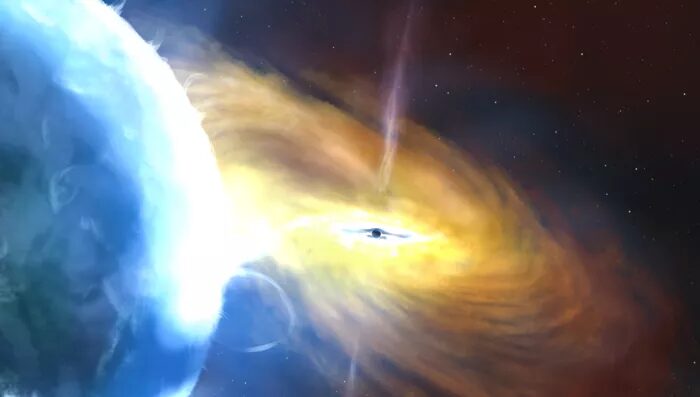Astronomers have
spotted a giant explosion releasing over 100 times more energy than the sun will release across its entire lifetime. A monster black hole is likely to blame.

© John A. PaiceAn artist's impression of a black hole sucking in a cloud of hydrogen gas.
Astronomers spotted the event, named AT2021lwx, 8 billion light-years from Earth. Releasing roughly 100 times the energy the sun will release over its entire lifetime, the strange explosion burst into activity when the universe was 6 billion years old.
"We came upon this by chance, as it was flagged by our search algorithm when we were searching for a type of supernova," study lead author
Philip Wiseman, an astronomer at the University of Southampton in the U.K.,
said in a statement. "Most supernovae and tidal disruption events [bright flashes that occur when black holes tear apart wandering stars] only last for a couple of months before fading away. For something to be bright for two plus years was immediately very unusual."
The cause of the mysterious explosion is unclear, but astronomers think it's most likely the result of a gigantic cloud of hydrogen gas thousands of times larger than our sun being gobbled up by a supermassive
black hole.
As chunks of the cloud are swallowed, shockwaves travel across the remaining hot gas, producing a giant explosion whose light has been bombarding Earth for more than two years and is yet to die out. By using two telescope systems designed for full-sky surveys — the Zwicky Transient Facility in California and the Asteroid Terrestrial-impact Last Alert System (ATLAS) in Hawaii — the researchers detected the distant event's bright, flashing light.
Black holes are born from the collapse of giant stars and grow by gorging on gas, dust, stars and other black holes. For some of these gluttonous space-time ruptures, friction causes the material spiraling into their maws to heat up and emit light that can be detected by telescopes — turning them into so-called active galactic nuclei (AGN).
The most extreme AGN are quasars — supermassive black holes billions of times heavier than the sun that shed their gaseous cocoons with light blasts trillions of times more luminous than the brightest stars.
Yet despite having a brightness on the scale of a quasar, the explosion is too short-lived to be one.
"With a quasar, we see the brightness flickering up and down over time. But looking back over a decade there was no detection of AT2021lwx, then suddenly it appears with the brightness of the brightest things in the universe, which is unprecedented," co-author
Mark Sullivan, a professor of astronomy at the University of Southampton, said in the statement. This means the explosion is likely to be from a gas cloud that was initially safely orbiting the black hole but got knocked off course to be sucked into the cosmic monster's maw.
To confirm the identity of the object causing the explosion, the researchers are now studying the explosion in more detail by scanning across wavelengths. This could reveal its surface shape, temperature and the mysterious processes that are generating the bright light.
The researchers published their findings May 11 in the journal
Monthly Notices of the Royal Astronomical Society.
Science is becoming increasingly questionable by virtue of its make it up as they go along attitudes.